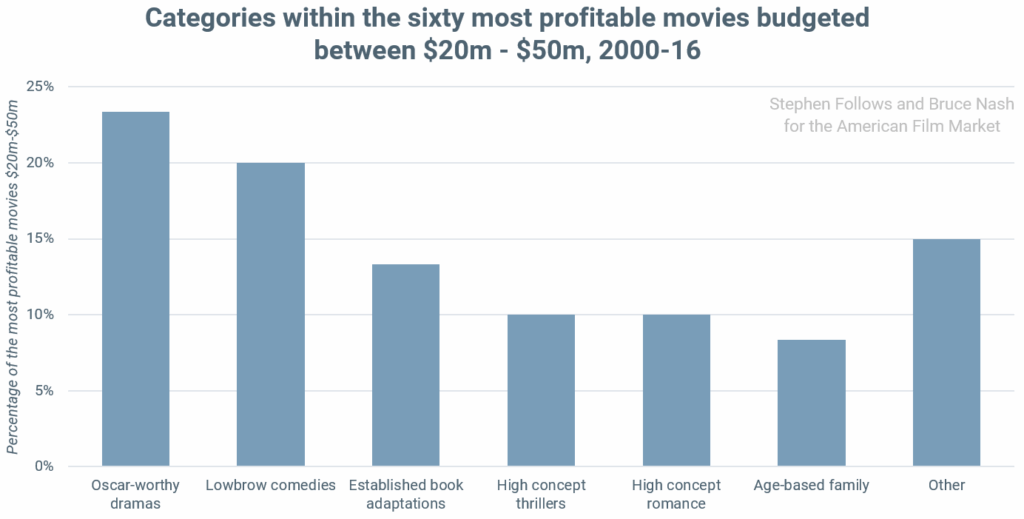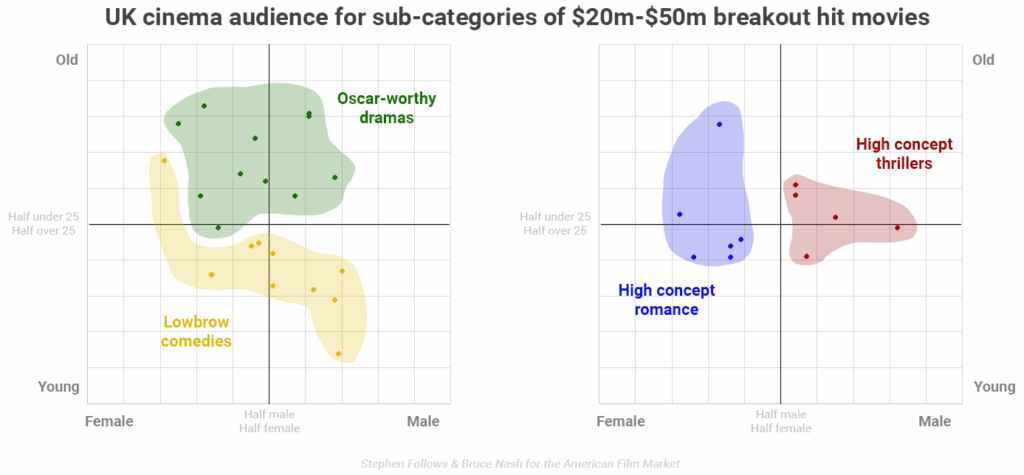PRODUCER RESOURCES
WHAT TYPES OF $20M – $50M FILMS BREAK OUT?
Last year, we took a look at what it takes for a low-budget film to become a break out hit, and discovered that the most successful movies came from a small number of specific genres. Twelve months on, we thought it would be interesting to take a look at films at the top end of the “independent” budget range, and see if the hits in this budget range also share some of the same DNA.
To do this, we compiled an analysis of the sixty most profitable movies budgeted between $20 million and $50 million, released between 2000 and 2016: roughly three films a year from the period under consideration. For more details of our methods and criteria, see the Notes section at the end of this piece.
Last time around, we found all the successful films fell into one of four categories. At this higher budget level, things are a little more diverse, but there are still a relatively small number of models that seem to produce the huge hits.

Let’s look a closer look at each of these categories.
Model One: Oscar-Worthy Dramas

- Dramas which have been nominated for either Best Picture or a Best Screenplay award at the Academy Awards.
- Including: The Help, Silver Linings Playbook, The Blind Side, Million Dollar Baby, Finding Neverland, About a Boy, True Grit, Ray, American Hustle, Straight Outta Compton and Bridge of Spies.
- 50% were PG-13, 43% were R-rated and one film was rated PG.
This is the biggest category of films we found, with 14 movies, and the rule here is simple: get a great script, great cast and crew, visionary director, and let them do their thing. Notably, this is the only category that’s a holdover from last year’s study of low-budget films: at all budget levels, quality pays off.
Model Two: Lowbrow Comedies With Broad Appeal

- Comedies with a gross-out component and broad appeal.
- Including: The Hangover, Ted, The 40 Year-Old Virgin, Knocked Up, Bridesmaids, Old School, We’re the Millers, Paul Blart: Mall Cop, Ride Along, Zombieland, Mr. Bean’s Holiday and 21 Jump Street.
- 75% were R-rated.
The general rule among comedies seems to be not to assume too much intellectual capacity from your audience. That’s not to say that these films aren’t well-written (far from it), but there are precious few jokes about Camus or deep themes in these films. All of these films did well at the box office, but they also played well on video—some of them would have made the top 60 anyway, but cranking out big sales and/or rentals on the home market really helped all of them.
Model Three: High Concept Thrillers

- Thrillers with a clear, one-line hook.
- Including: Taken, Lucy, Limitless, District 9, Looper and V for Vendetta.
- Mostly sci-fi with Taken being the only exception.
The secret for thrillers seems to be to produce something that has a strong “hook,” and then stick to it. Watching the trailer tells you most of what you need to know about these films, perhaps with a bit of a mystery about how they will end (although the Taken films don’t really have much mystery about even that). This is another group of films that benefit from high demand on video.
Model Four: Adaptations of Books With An Established Audience

- Based on a highly successful novel, and often produced by a Hollywood major.
- Including: Twilight, Fifty Shades of Grey, The Notebook, The Maze Runner, Shrek, Hauru no ugoku shiro (Howl’s Moving Castle), Bridge to Terabithia and Dear John.
Although our focus is mostly on independent films, and studio productions tend to exceed $50 million these days, there are a few cases (eight, to be precise) where a studio has bought the rights to a very popular book, managed to keep their budget below $50 million, and made a tidy profit. The common theme here is that the films mostly pleased the existing fans of the books.
Model Five: High Concept romances

- Movies targeted almost exclusively at women.
- Including: The Devil Wears Prada, The Proposal, Bridget Jones’s Diary, Sweet Home Alabama, P.S. I Love You and Serendipity.
- All but one are PG-13.
This category is something of a counterpart to the thrillers. If that list was the top films that a group of guys might rent on a Friday night, this (along with a few of the book adaptations above) might be the top films for a girls’ night in. Again, a clear hook, interesting female leads and a strong delivery are key.
Model Six: Age-Reversal Family Films

- Family films with either adults acting like children or children acting like adults.
- Including: Elf, Freaky Friday, The Karate Kid, Spy Kids and The Game Plan.
- All were PG-rated.
We expected to see some family films on this list, but what’s striking about it is that the hook in all but one of them is adults acting like kids or vice versa. Kids seem to love that stuff, and these films not only played well in theaters, but are perennial top-sellers on video. It’s worth noting that Mamma Mia, another movie in a similar vein, misses this list simply because its reported budget was $52 million. Worldwide, it was the top-selling video released in 2008.
Analysis
The main takeaway from this research is that these types of breakout hits are very clear, high concept movies. They promise the audience one particular thing… and then fully deliver on that pitch. It’s almost like the filmmakers are saying to the audience “We’re not being clever – it’s a film about x”.
Perhaps unsurprisingly, we can see the effect of such simple narratives in the types of people who pay to see these movies. Using UK cinema audience data, we are able to show how the audience differs for four of these major groups.

High Concept Thrillers played to a majority male audience (four-fifths of the audience for Looper were male) and the High Concept Chick Flick played to majority-female audiences (The Devil Wears Prada audience was four-fifths female).
When we focus on Oscar-worthy Dramas and Lowbrow Comedies we can see a clear split, not by gender but by age. All but one of the dramas played to audiences who were, on average, over 25 years old (the one holdout being Silver Linings Playbook). Conversely, all but one of the Lowbrow Comedies played to audiences who were on average under 25 years old, with Bridesmaids being the one exception.
Notes
- In order to conduct this study, we began with a list of over 3,000 films from The Numbers’ financial database, investigating full financial details, including North American (i.e. “domestic”) and international box office, video sales and rentals, TV and ancillary revenue. We narrowed our focus to study feature films released between 2000 and 2016 and budgeted between $20 million and $50 million. Finally, we calculated the likely profit margin for the producers, after all revenue and expenses were taken into account.
- The financial figures come from a variety of sources, including people directly connected to the films, verified third-party data and computation models based on partial data and industry norms. It is possible that one or two of the individual figures are different to our predictions, though en masse we are confident of the larger picture.
- Sequels were excluded as their success could be attributed to their existing audience. This affected Pitch Perfect 2, The Fast and The Furious, Twilight: New Moon and Taken 2.
- We had audience data for 77% of the films in our dataset, hence why some movies are missing the final charts.
- We counted Mystic River, Flight and Gran Torino in the ‘Oscar-worthy Drama’ category, despite not receiving Best Picture or Screenplay Oscar nominations, because they fit the other characteristics of this group.
- It could also be argued that four of the uncategorized films in our dataset (Walk the Line, Remember the Titans, Oh Brother Where Art Thou and Chicago) were aiming to be Oscar-worthy Dramas, although we erred on the side of caution for the research. If one were to take this generous approach, then that would bring the number of such movies to 18. In other words, 30% of the most profitable films made for between $20 million to $50 million (2000-16) were Oscar-worthy Dramas.
About the Authors
Stephen Follows is a writer, producer and film industry analyst. His film research has been featured in the New York Times, The Times, The Telegraph, The Guardian, The Daily Mail, The Mirror, The Evening Standard, Newsweek, The New Statesman, AV Club and Indiewire. He acted as an industry consultant and guest on the BBC Radio 4 series The Business of Film, which topped the iTunes podcast chart, and has consulted for a wide variety of clients, including the Smithsonian in Washington. In addition to film analytics, Stephen is an award-winning writer-producer and runs a production company based in Somerset House, London.
Bruce Nash is the founder and President of Nash Information Services, LLC, the premier provider of movie industry data and research services and operator of The Numbers, a website that provides box office and video sales tracking, and daily industry news. Mr. Nash founded the company in 1997 and it now serves approximately 1,000 clients, from the major studios to first-time independent filmmakers. Mr. Nash provides regular commentary and analysis for media outlets, including the L.A. Times, the New York Times, Variety, the Wall Street Journal, 60 Minutes, and CBS News. Mr. Nash is the official adjudicator of movie records for the Guinness Book of Records. To learn more about his company’s services, visit Nash Information Services.
Copyright © 2021 Stephen Follows and Bruce Nash. All rights reserved. Reproduced with permission.
Explore more articles and research at Producers Resources.